Following the great effort put into the organization of the 2020 Tokyo Olympics and Paralympics, the Japanese government is aiming at launching an entrepreneurial idea for urban regeneration of the country’s capital. The initiative, dubbed “Tokyo 2030: As part of the “Green and Smart,” plan, the city aims to retrofit extensive scopes of the megapolis that would emerged as environmentally friendly, ICT-enabled communities and a reference for other global cities.
Part of the implementation plan of TMRA announced soon after its Formation, the project involves a master plan to Redevelop several areas of Tokyo among them being the ex Olympic Village. The essence of the initiative is the promotion of environmentally friendly and sustainable urban environment, green technologies, renewable energy, green areas, development of smart city.
A major component of the plan is the transformation of the Olympic Village into a multifunctional sustainable urban quarter. According to the plan, the area will consist of sustainable residential structures with special emphasis on energy consumption, communal gardens and common areas created with focus on peoples’ interaction and health services. The roofs of buildings will also include solar panels and wind turbines, which will help meeting power consumption mostly within the outlined district.
The TMRA has also envisioned a stringent web of green corridors all over Tokyo and a plan of adding to existing parks to form new urban trees. Such green spaces will also offer recreational land for those in the housing estates but also function as ‘cooling’ systems in the fight against the notorious urban heat island syndrome a major issue affecting congested cities like Tokyo.
Transportation is another area that implementing renewal project to improve transport services in the area. This plan provides step by step detailed plans on plans of further developing the already advanced public transport system in Tokyo through electric and autonomous vehicles. To enhance active transport, the city will enhance a dedicated cycling network and will also ensure that streets that are more pedestrianized are developed.
Technology will play a crucial role in the realization of the “Tokyo 2030: Green and Smart” vision. The project envisages the widespread use of Internet of Things (IoT) devices and artificial intelligence systems to improve energy efficiency, traffic regime, and waste disposal systems. Singapore plans on using smart technologies integrated onto the streets such things as intelligent lighting posts, traffic signals, and real-time air quality sensors.
The fundamental idea that has been put into practice has provoked controversy within the sphere of urban planning as well as ecology. Some proponents of the idea call it progressive and the right thing in the context of climate change and advancement in technology for cities. The main criticism has been the cost of the project and its effects it might have on the surrounding societies.
In response to such issues, the TMRA has continued to affirm its social 주민 participation and justice throughout the planning and executing phases. To engage the stakeholders, the agency has planned public hearings and workshops to be conducted throughout the city in an attempt to capture the community opinions and guarantees the renewal project will be equally beneficial for all the demographic profiles of Tokyo’s society.
The economic implications of the “Tokyo 2030: The implications pertaining to the “Green and Smart” project are enormous. Much of the employment impacts are anticipated to be derived in areas such as construction of the new industries in technology, and green energy. Besides, the government believes that the project will attract overseas investment and promote sustainable urban growth of Tokyo.
There are keen-interests from several Japanese large companies ready to bring the vision to life with the TMRA. Currently, companies such as Sony and Panasonic are considering how to incorporate their most effective smart home technologies, as well as the IoT to new buildings, while the building contractors are looking for effective materials and constructions techniques to address the sustainability objectives of the project at hand.
Tokyo urban renewal project has attracted the attention of the international community. Many urban planners as well as policy makers together with counterparts from other cities throughout the world are interested in replicating such concept in their new initiatives in Tokyo. The outcome of this example may define the further experience of worldwide cities concerning climate transformation, population density, and technological input integration.
Possibly during the execution most of or even some of these strategic steps may not work as planned but that is part of the process of implementation of any project. However, the “Tokyo 2030: ”Green and Smart” is a measure that provides the indication of the serious efforts towards making the cities of the future more sustainable. If successful, it could act as a guide to cities worldwide, showing how the expertise gained from staging such events as the Olympics can actually transform urban spaces and processes for the majority’s benefit.




